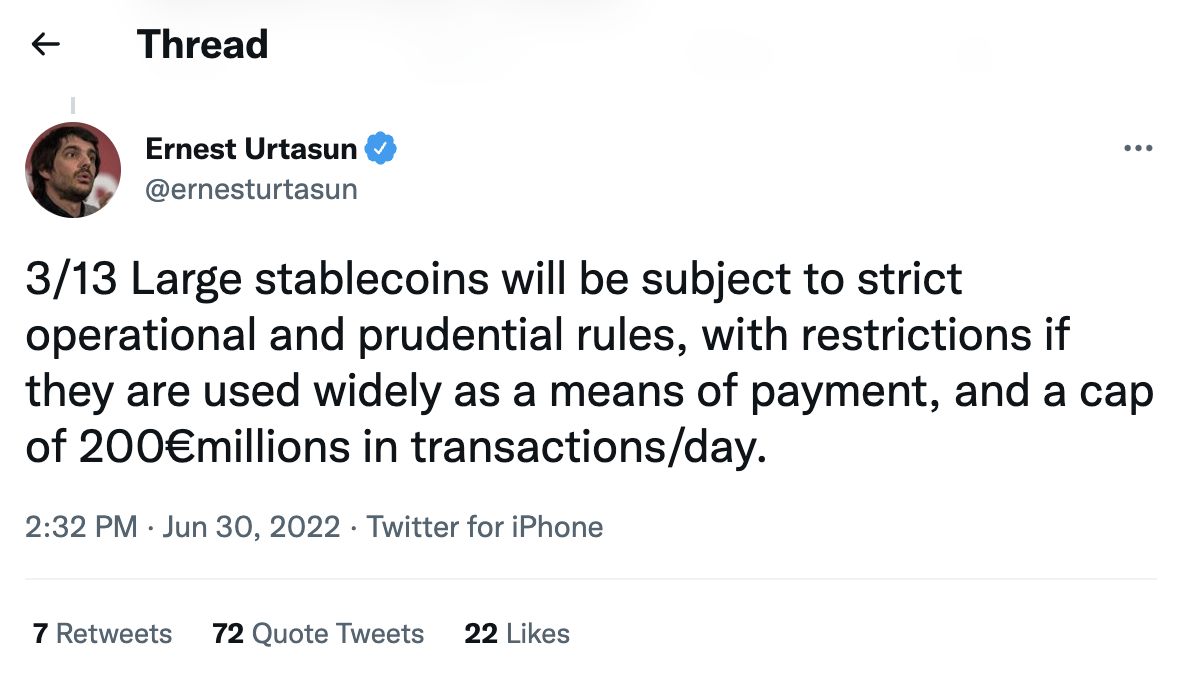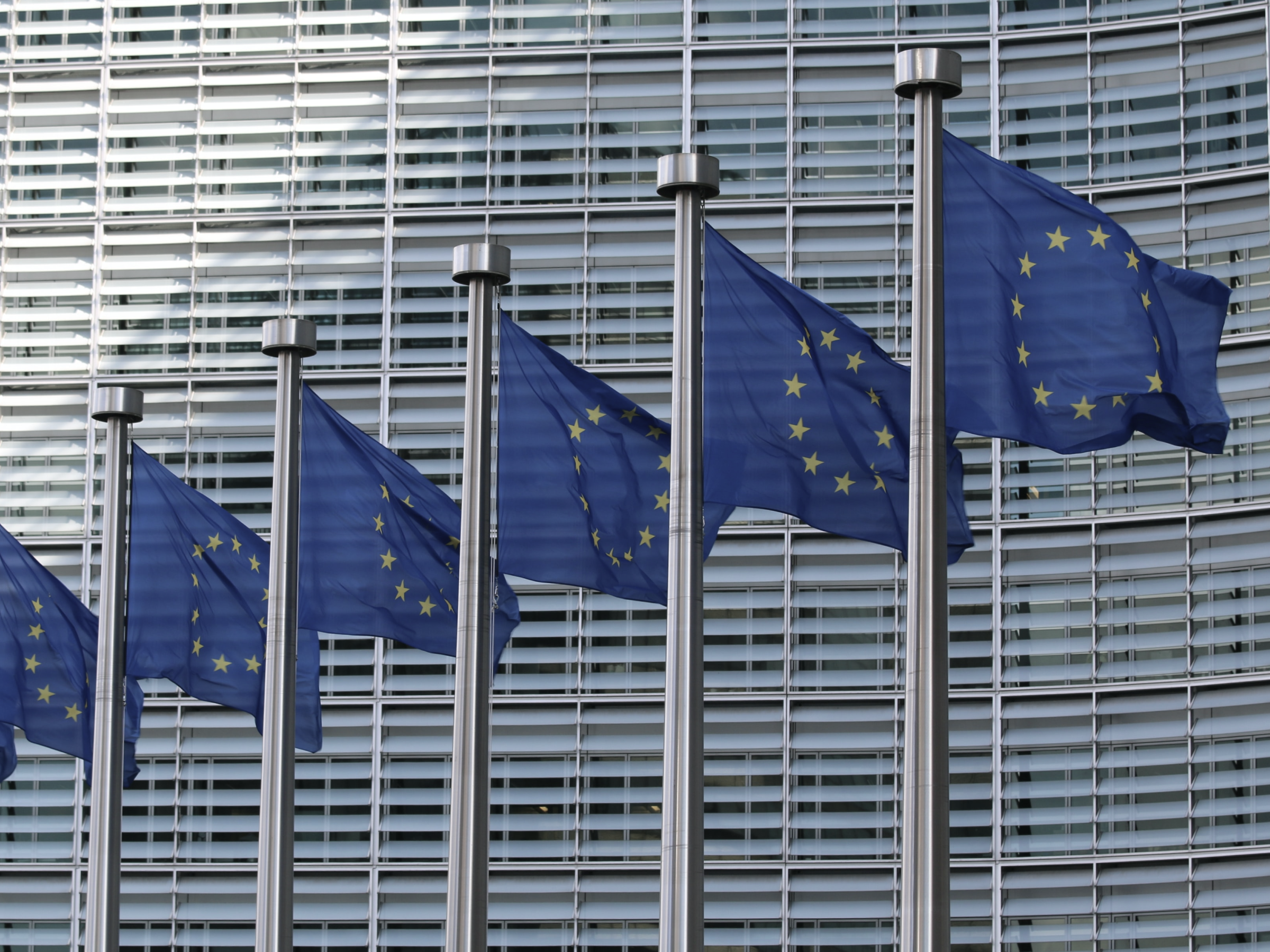Update as of December 8, 2022
The political outline of the legislation was approved in June, with the final text published in October. A previous tentative plan for the EU Parliament to vote on it in December has been delayed and will now likely not occur util February of 2023. The law’s provisions were to start to apply between 12 and 18 months after the final law is published – an event originally planned for spring of 2023, but which now seems set to be pushed back.
Back on September 24, 2020, the European Commission (EC) adopted an expansive new Digital Finance Package meant to transform the European economy. The overall aim of the package was to improve competitiveness for the EU’s Fintech sector, while promoting financial stability and mitigating risk throughout the European economy. Included in this package is a new regulatory framework proposal on crypto-assets, called Markets in Crypto-Assets (MiCA), that was developed to streamline distributed ledger technology (DLT) and virtual asset regulation in the European Union (EU) while simultaneously protecting users and investors. On June 30, 2022, after two years of discussions and debates, officials from the EU announced an agreement on the landmark Markets in Crypto Assets (MiCA) regulations.
This agreement focuses strongly on rules to regulate crypto-assets such as stablecoins, as well as crypto-asset service providers, referred to as CASPs, (as opposed to Virtual Asset Service Providers – VASPs – a term used by the Financial Action Task Force). MiCA defines CASPs as “any person whose occupation or business is the provision of one or more crypto-asset services to third parties on a professional basis.” MiCA’s CASP definition has some similarities to the FATF’s VASP definition, but is broader in scope to ensure it covers more entities
The EC has recognized European CASPs currently do not have the benefits of Europe’s internal market for financial services due to a “lack of both legal certainty about the regulatory treatment of crypto-assets as well as the absence of a dedicated and coherent regulatory and supervisory regime at EU level. ” Crypto firms cannot “passport” their licensing across the EU the way it is done in traditional financial services. This is forcing governments to develop customized national frameworks to regulate these businesses. These different frameworks and regulations hamper innovation and limit CASP’s abilities to scale their operations across the EU. This results in an “uneven playing field” for CASPs based on their member state.
MiCA Overview
MiCA will be applicable across the European Union (EU) to all member states once it is adopted. It proposes a legal framework for assets, markets, and service providers that are currently not regulated on an EU-level and makes it possible to provide licensed services across the EU. Several key points if MiCA gets adopted:
- The regulation will directly apply to all current 27 EU Member States
- Implementation in national law will not be required.
- It will also affect any firm seeking to do business in the EU; client prospecting from anywhere outside the EU ( including the US, UK and Singapore for example) will be a regulated activity
MiCA has 4 broad objectives
- To provide legal certainty for crypto-assets not covered by existing EU financial services legislation
- To establish uniform rules for crypto-asset service providers and issuers at EU level
- To replace existing national frameworks applicable to crypto-assets not covered by existing EU financial services legislation
- To establish specific rules for so-called ‘stablecoins’, including when these are e-money.
MiCA has defined three Crypto-asset types
- Asset-referenced tokens: These are tokens that aim to maintain a stable value by “referencing several currencies that are legal tender, one or several commodities, one or several crypto-assets, or a basket of such assets.” These tokens can be used as means of payment to buy goods and services and as a store of value.
- E-money tokens: This is another name for single fiat stablecoins. These are crypto-assets with a stable value based on only one fiat currency that aims to function similar to electronic money
- Utility tokens: These are to be issued with non-financial purposes to digitally provide access to an application, services or resources and is only accepted by the issuer of that token. These tokens have a non-financial purpose related to the operation of a digital platform and digital services
For each of these three categories, MiCA sets forth guidelines that CASPs must follow in order to ensure transparency, enable consumer protection and mitigate risks of market abuse. With a look back to the traditional finance world’s prospectus document, MiCA prohibits a CASP from offering to the public (or seeking admission to trading on a trading venue crypto assets) unless a white paper complying with the regulation has been prepared. In addition to notifying the relevant regulatory authority, the published white paper must include information on the characteristics, rights/obligations, and the underlying technology of the offering.
Out of scope
While MiCA broadly encompasses cryptocurrencies, along with stablecoins, it does not apply to central bank digital currencies (CBDCs) nor does it regulate security tokens that might qualify as securities or other financial instruments.
While there has been discussion of emerging technologies such as decentralized finance (DeFi) and non-fungible tokens (NFTs) both are excluded within this version of MiCA
EU Passport
One of the biggest perceived benefits of MiCA is passpoting. Under MiCA, when looking to extend operations across EU countries, CASPs must obtain approval from regulatory authorities in an EU country. Once local authorities have approved a crypto business according to EU regulations, that CASP would then be able to extend operations to other EU countries without having to obtain additional licenses, a process called passporting.
CASP Approval
CASPs will face capital requirements and will need to create policies and procedures for allowing the trading of crypto-assets on its platform. According to the announcement, “under the provisional agreement reached today, crypto-asset service providers (CASPs) will need an authorisation in order to operate within the EU. National authorities will be required to issue authorisations within a timeframe of three months,” so the expectation is that the registration process would not be a long, difficult process.
Consumer Protection
The EU is clearly looking to enhance consumer protection when it comes to crypto assets. Under MiCA, crypto-asset service providers will have to “respect strong requirements to protect consumers’ wallets and become liable in case they lose investors’ crypto-assets.” According to the announcement, MiCA “will also cover any type of market abuse related to any type of transaction or service, notably for market manipulation and insider dealing.”
Anti-Money Laundering
EU officials reached an agreement on updated AML legislation which also covers crypto-assets. On the Transfer of Funds regulation, MiCA simply adopted this legislation, which requires an originator CASP to share customer information with the recipient CASP in every transaction without thresholds or exceptions (“Travel Rule”). Payments to unhosted private wallets, a challenge across the industry, has been left out of the requirement. This is a significant departure from prior drafts.
MiCA also relies heavily on guidance from the Financial Action Task Force (FATF). In an interesting reference in MiCA’s consideration (8), it states that “any legislation adopted in the field of crypto-assets should be specific, future-proof and be able to keep pace with innovation and technological developments . . . Such legislation should also contribute to the objective of combating money laundering and the financing of terrorism. Any definition of ‘crypto-assets’ should therefore correspond to the definition of ‘virtual assets’ set out in the recommendations of the Financial Action Task Force (FATF).”
Stablecoins
According to the announcement, MiCA will protect consumers by requesting stablecoins issuers to build up a sufficiently liquid reserve, with a 1/1 ratio and must be entirely “segregated and insulated.” The announcement also states that ‘every so-called “stablecoin” holder will be offered a claim at any time and free of charge by the issuer, and the rules governing the operation of the reserve will also provide for an adequate minimum liquidity.”
Additionally one of the most controversial points occurred when European Parliament lawmaker Ernest Urtasun tweeted that the agreement will include a strict cap on stablecoin usage.

Source: Twitter
According to the Urtasun tweet, “large” stablecoins will be limited to €200 million worth of transaction volume per day. The exact nature of this remains unclear, but regardless of exactly how it’s enforced, such a cap would drastically change the way stablecoins are used. To put this into perspective, as of July 1, 2022, Tether’s 24-hour trading volume globally was $53.5 billion.
Next steps
MiCA at this point remains a bill that still needs to be passed. The main features have been agreed to in principle by lead negotiators, but a full text is not yet available (only the Sept 24, 2020 is available). Once the text is available, governments and lawmakers at the European Parliament will have to agree and approve through a series of votes.
It is expected that passage of the law will follow the expected timeframe called out in the Sept 2020 announcement and will likely not come into effect until 2024. Even after the law is passed, CASPs will likely have an 18 month grace period to comply with the regulation.
MiCA is a major step, but likely not the last, from the EU on crypto regulation. It is likely that MiCA’s official enforcement by 2024 will spell an end to all EU member states’ national crypto policies, in favor of a single, focused regulatory framework. The hope is that this will facilitate the end goal of allowing EU crypto-asset service providers to operate with greater ease across all EU markets, albeit under stricter rules.



